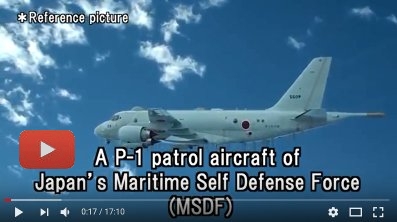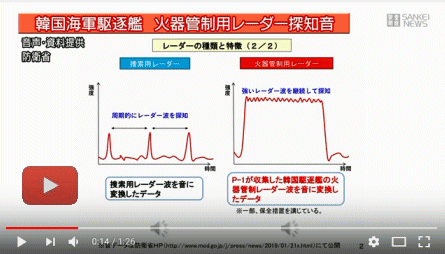
Chronology of Events
- December 20, Thursday
-
The Maritime Self-Defence Force's (MSDF) P-1 patrol plane was locked-on to by a South Korean Navy Gwanggaeto-daewang class destroyer around 3pm last Thursday (Dec 20) off the Noto Peninsula in the Sea of Japan.
- December 21, Friday
-
The Japanese government has lodged a strong protest with South Korea. In a press conference, Japan's Defense Minister IWAYA takeshi, speaking to reporters at his ministry, described the action as "extremely dangerous that could cause an unexpected situation."
In response to the Japan’s protest, South Korea’s defense ministry said its destroyer was performing routine operations, saying “We were operating the radar as part of the operation but it was not intended to trace any Japanese patrol aircraft,” the ministry said in a statement.
- December 22, Saturday
-
The S. Korean Navy on Friday dismissed Japan's claim that a South Korean warship directed fire-control radar at Tokyo's patrol aircraft a day earlier, saying the neighboring country misunderstood its operation to help a North Korean ship drifting near a sea border.
"The vessel used fire-control radar not because of the P-1, which was flying in Japan's air defense identification zone, but because we tried to trace a North Korean warship drifting near the inter-Korean sea border," a Navy official told Yonhap News Agency on condition of anonymity. The official added that the Navy ship appears to have used both fire-control radar and navigation radar to more accurately locate the North Korean vessel moving toward the Northern Limit Line in the East Sea.
- December 24, Monday
-
"While rescuing a distressed North Korean fishing boat, the destroyer had used an optical camera that detected a low-flying Japanese patrol plane," an official from Sout Korea’s Joint Chiefs of Staff said.
"During the process, there was no emission of radio waves at all,” he said, denying that the warship had locked its tracking radar on the Japanese arcraft.
- December 27, Thursday
- First working-level talk between Japan and S. Korea (through teleconferencing) ended up without any progress.
- December 28, Friday
-
Japan’s defense ministry has released footage of an incident on December 20 in which a Republic of Korea Navy destroyer trained its fire-control radar on a Japanese maritime patrol aircraft off the Noto Peninsula in the Sea of Japan.

Filmed from aboard the Kawasaki P-1 fixed-wing patrol aircraft of the Japan Maritime Self Defense Force (MSDF), the footage shows that destroyer ROKS Gwanggaeto the Great (DDH-971) directed a fire-control radar at the plane, Japan says.
As explained by Japan’s defense ministry, the footage contains scenes where the MSDF P-1 is hit multiple times continuously over a certain period by the fire-control radar.
The footage also shows tat the MSDF P-1 called out “KOREA SOUTH NAVAL SHIP, HULL NUMBER 971” in English in an attempt to confirm the intent of the radar irradiation. In addition, it was recorded that the MSDF P-1 was flying at a certain altitude and distance safe enough from the destroyer.
“We express deep concern and regret” over the unilateral release of the footage, the South Korean defence ministry said in a statement on Friday.
“As we have stated repeatedly, the Gwanggaeto destroyer was engaging in a normal rescue operation and it remains as a fact that the ship did not use” the fire-control radar, it said.
- January 2, Wednesday
-
South Korea’s defense ministry has released a video bolstering its demand that Japan stop “distorting the truth” and apologize for a patrol plane which allegedly flew dangerously close to a Korean ship.

→[Transcrpt of the Video foottage with no BGM] We reiterate the fact that the ROK Navy did not operate STIR (Fire-control radar) against Japan’s patrol aircraft.
- January 14, Monday
- The second round of working-level meeting was held in Singapore.
In this meeting, the Japanese-side officials expressed their willingness to provide FC radar frequency data collected by the P-1 parol plane under the closed circumstance keeping secrecy for the militarly data subject to the condition that the S. Korean-side also provides their own FC radar frequency data for cross-checking.
However, S. Korean-side adamantly refused to accept Japan's proposal calling it "extremely offensive demand, which S. Korea is unable to accept" "Japan's assertion indicates that Japan has no intention to solve the problem." - January 21, Monday
-
The Defense Ministry of Japan announced Monday it will terminate talks with its South Korean counterpart over the radar lock-on dispute, while revealing what it claims are sounds, converted from radio waves, of the fire-control radar system of a South Korean destroyer.
The final statement issued by the Defense Ministry of Japan writes that: the claims of S. Korea often change and are not consistent; leading them to consider that S. Korea is unreliable; talks with them will not contribute to the descovery of the truth; and therby it decided to terminate the talks.

